Agusta-Bell AB206C-1 JetRanger
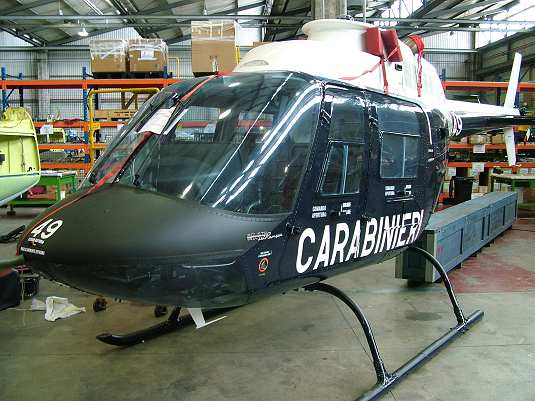 |
||||||
| Agusta-Bell AB206C-1 JetRanger II, c/n 9151, MM-80927, CC-49, arrived at The Museum on 30th April 2012, having travelled by road from Frosinone, 75km south-east of Rome. | ||||||
| Built at Cascina Costa, in Italy, by Agusta under licence from Bell, it was delivered to the Carabinieri in September 1974 and remained in service until 2008 based, for most of that time, at Pratica di Mare, on the coast 25km south-west of Rome. | ||||||
| The aircraft has been carefully restored, in recent months, by AgustaWestland workers at the Frosinone facility. | ||||||
In addition to more than forty Agusta-Bell AB206s the Carabinieri have been equipped with at least thirty Agusta-Bell AB412s and, since 2007, an increasing number of new AW109N Nexus. Twenty Carabinieri AB206s, recently withdrawn from use after replacement by more modern AW109 variants, are being transferred to the Argentine Army in exchange for three surplus Alenia G-222 transport aircraft |
||||||
The Carabinieri |
||||||
| Founded in 1814 to defend the nation and maintain public order, the Carabinieri formed part of the Italian Army until 2001 when they became a fourth component of the armed forces alongside the Navy, the Army and the Air Force, and provided them with a military police service. Influenced by their military ties, including extensive recruitment from retired Army personnel, they are seen as more proactive than the French Gendarmerie to whom they are often compared. |  |
|||||
| The Carabinieri are a paramilitary corps, with civil and military police duties, and have actively participated in all Italy's military conflicts in addition to many UN peacekeeping missions, including those in Somalia, Lebanon, Bosnia, Kosovo, Afghanistan and Iraq. | ||||||
| Their primary responsibilities in the field of civilian police duties cover issues such as organised crime, fraud, public health and riot control. In recent times there have been efforts to make the Force more accessible to the public and the local institutions by appointing community officers to assist with their problems. | ||||||
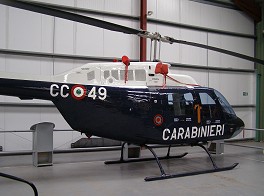 |
 |
 |
||
The Bell Model 206 JetRanger |
||||
| Agusta, previously best known
for its line of MV Agusta motorcycles, entered the rotorcraft market
in May 1952 by acquiring a licence to build the Agusta-Bell 47G
in Italy, a strategy which was eventually extended to include, among
others, the AB206B JetRanger II, the HH-3F Pelican and the AB212.
Licence agreements with Sikorsky led to production of the AS-61
series and, with Boeing, the Meridionali CH-47C Chinook.
Larry Bell set up the Bell Aircraft Company in July 1935. In mid-1960 Textron, a newly-formed industrial conglomerate, bought Bell Helicopter Corp. and most of the other Bell units for about $18 million. In 1960 the United States Army, having replaced its Bell 47 medevac
helicopters with the Bell UH-1 Huey, were seeking a new helicopter
to replace the Bell H-13 Sioux and its other light helicopters,
as scout/liaison machines. Thus the Light Observation Helicopter
(LOH) acquisition programme was launched. Bell's response, which
the US Army called the YOH-4, was rejected as 'too heavy' and
in 1965, the Hughes Model 369 offering, the YOH-6, was selected.
By this time the Army were deeply involved in the Vietnam conflict,
its requirement for helicopters was multiplied, Hughes were failing
to meet production targets, the YOH-6 unit price had doubled and
the Army's budget was under strain. Consequently the LOH competition
was reopened in hopes that a lower price could be negotiated. Many of the ensuing JetRanger civil and military variants were sold worldwide and additional large scale production, under licence, was carried out by Agusta, at Cascina Costa and Frosinone, in Italy. In 1986 Bell transferred all American JetRanger civil production from Texas to a new factory at Montreal-Mirabel. Production was maintained until 2010 and the type continues in widespread service today. |
||||
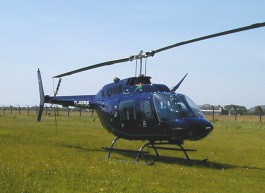 |
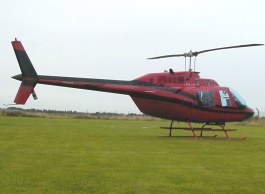 |
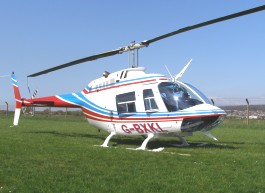 |
||
| Bell 206B JetRanger III, G-HEBE, visited the Museum on 1st June 2002 | Bell 206B JetRanger III, G-TGRZ, flew in from Shobdon on 6th August 2005 | Bell 206B JetRanger III, G-BXKL, arrived from Thruxton on 18th April 2007 | ||
| A period of financial problems
at Agusta, in the 1980s, eventually saw the company come under the
ownership of Finmeccanica S.p.A. in Italy and a financial restructuring
ensued. A long period of collaboration with Westland Helicopters
in the UK, which included development and production of the EH101
(AW101), culminated in the amalgamation of Westland and Agusta,
as AgustaWestland under Finmeccanica sole ownership, in 2004.
Chairman of THM Trustees, Elfan ap Rees said, "We are grateful to AgustaWestland for their continued sponsorship and support of The Helicopter Museum and, in particular, for working with us to save and conserve historic examples like the JetRanger. We also want to thank the staff at Frosinone for the superb restoration work which they have carried out". |
||||
 |
||||